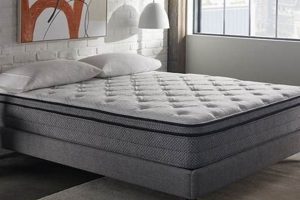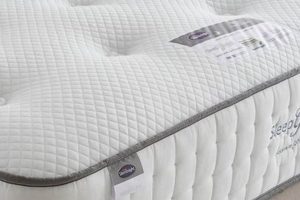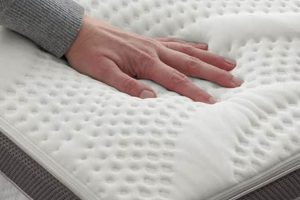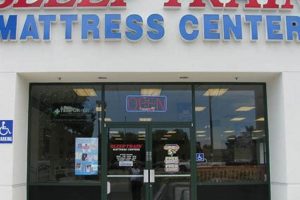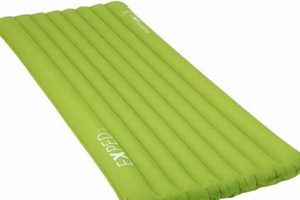An integral component of convertible furniture, the cushioning specifically designed for fold-out beds offers support and comfort for individuals utilizing this dual-purpose furnishing as a sleeping surface. For example, a memory foam layer atop coiled springs within a trifold structure provides a balance between ease of storage and ergonomic alignment.
The crucial role these supportive surfaces play extends beyond mere convenience. A properly selected sleeping surface can significantly impact spinal health and overall sleep quality. Historically, these surfaces were often thin and uncomfortable, but advancements in material science and design have led to improved options that more closely resemble traditional bed mattresses, offering enhanced support and durability.
The following sections will delve into the various types available, factors to consider when selecting one, and how to maintain its quality over time, ensuring optimal comfort and longevity.
Essential Considerations
Optimizing the comfort and longevity of a convertible bed requires careful attention to several key factors. The following tips provide guidance on selecting and maintaining this critical component.
Tip 1: Prioritize Dimensions. Ensure the replacement fits the sofa bed frame precisely. Accurate measurements of the internal frame dimensions are crucial to prevent gaps or overhang, both of which can compromise support and comfort.
Tip 2: Evaluate Thickness Carefully. Thicker options do not always equate to superior comfort. Consider the folding mechanism of the sofa bed. An excessively thick surface may hinder proper closure of the unit.
Tip 3: Material Selection is Paramount. High-density foam or memory foam is generally preferable for firmness and pressure relief. Inner spring options offer a more traditional feel but can be less durable under repeated folding and unfolding.
Tip 4: Examine Density Specifications. For foam variants, a higher density rating indicates greater support and resilience against compression over time. Lower density foams are prone to sagging and premature wear.
Tip 5: Consider a Protective Cover. A water-resistant and breathable cover safeguards against spills, stains, and dust mites, extending the life of the cushioning and promoting hygienic sleep.
Tip 6: Rotate Regularly. Consistent rotation helps to distribute wear evenly across the entire surface, preventing localized compression and prolonging the overall lifespan.
Tip 7: Address Support Issues Promptly. Should any sags, lumps, or tears become apparent, address them immediately to prevent further deterioration and maintain adequate support. Replacement may be necessary if damage is extensive.
Adhering to these recommendations facilitates the informed selection and diligent maintenance of a convertible bed cushioning, resulting in enhanced comfort and extended utility.
The subsequent section provides guidelines on troubleshooting common issues and maximizing the overall experience.
1. Thickness and Foldability
The relationship between thickness and foldability is paramount in the context of cushioning designed for convertible sofas. The dimensional constraints of the sofa’s folding mechanism directly influence the permissible thickness of the cushioning without compromising functionality.
- Impact on Sofa Closure
Excessive thickness impedes the seamless closure of the sofa bed. A too-thick surface may prevent the locking mechanism from engaging, rendering the sofa unusable in its seating configuration. Conversely, insufficient thickness may result in inadequate support and discomfort.
- Compression Rate and Material Selection
The compression rate of the material affects how easily the unit folds. High-density materials, while durable, may resist compression, requiring greater force for folding. Material selection must balance compression with long-term support and comfort.
- Weight Distribution Considerations
Thickness influences weight distribution when the sofa is in both seating and sleeping configurations. Uneven weight distribution due to inappropriate thickness can lead to structural stress on the sofa frame and uneven wear on the cushioning itself.
- Optimal Thickness Parameters
A guideline for optimal thickness generally ranges from 4 to 6 inches, although specific recommendations vary based on the sofa bed’s design. Deviations from this range often result in functional compromises, either in terms of folding ease or sleep surface comfort.
Therefore, careful consideration of both thickness and foldability is crucial when selecting cushioning for convertible sofas. The dimensions must align with the sofa’s specific design to ensure seamless operation and user satisfaction.
2. Material Density
Material density represents a critical performance parameter in the construction of cushioning designed for convertible sofa beds. It directly correlates with support, durability, and overall comfort, significantly influencing the lifespan and suitability of the product for its intended purpose.
- Support and Spinal Alignment
Higher density materials offer enhanced support, which is crucial for maintaining proper spinal alignment during sleep. Inadequate support can lead to discomfort, back pain, and compromised sleep quality. For example, high-density memory foam contours to the body, distributing weight evenly and reducing pressure points, whereas low-density foam may compress excessively, failing to provide adequate support.
- Durability and Longevity
Density directly impacts the cushioning’s resistance to compression and deformation over time. Higher density materials retain their shape and supportive properties for a longer duration, withstanding repeated use and folding without significant degradation. Conversely, lower density materials are more prone to sagging, indentations, and loss of support, requiring more frequent replacement.
- Comfort and Pressure Relief
The interaction between material density and firmness influences comfort levels. A high-density material can offer a firm yet comfortable sleeping surface by providing both support and pressure relief. This balance is essential for individuals seeking a supportive surface that minimizes discomfort. For instance, a high-density latex offers both resilience and contouring, adapting to the sleeper’s body while maintaining its structural integrity.
- Weight Capacity and Structural Integrity
Cushioning density determines its ability to support varying weights without compromising its structural integrity. Higher density options are generally better suited for individuals with higher body mass, as they provide more robust support and resist excessive compression. Selection based on anticipated weight load ensures that the material maintains its shape and supportive characteristics over the long term.
These facets of material density underscore its fundamental role in determining the quality and performance of a sofa bed cushioning. Optimizing density is crucial for achieving a balance between comfort, support, durability, and longevity, ultimately contributing to a satisfactory user experience. Choosing a unit with appropriate density mitigates premature wear, ensuring the cushioning serves its function effectively over an extended period.
3. Support Structure
The support structure within a fold-out bed cushioning is integral to its performance and suitability as a sleeping surface. The type and configuration of this structure directly impact the level of support provided, which in turn affects spinal alignment, pressure distribution, and overall sleep quality. A substandard support system compromises comfort and can contribute to musculoskeletal issues. For example, a system lacking adequate reinforcement may sag prematurely, leading to an uneven sleeping surface that exacerbates pressure points.
Diverse structural approaches are implemented, ranging from innerspring coils to foam-based systems. Innerspring designs offer a familiar feel but may prove less durable than high-density foam alternatives, particularly under the stresses imposed by repeated folding and unfolding. Conversely, a well-engineered foam core can provide consistent support and conform to the body’s contours, minimizing pressure points. Proper distribution of weight across the support system is crucial; without it, localized sagging and uneven wear will occur. Examples of effective designs include multi-layered foam constructions with targeted support zones and coil systems utilizing interconnected springs for enhanced stability.
In conclusion, the support structure is a critical determinant of the effectiveness of a bed cushioning designed for convertible sofas. Its design and material composition dictate the level of support, durability, and comfort it provides. Neglecting this element can lead to diminished sleep quality and premature degradation of the cushioning, underscoring the importance of selecting an option with a robust and well-engineered internal support system. The long-term value is directly tied to the ability of the underlying structure to maintain its integrity and deliver consistent support throughout its lifespan.
4. Size Compatibility
The term “size compatibility” defines a foundational requirement in the context of mattresses intended for convertible sofa beds. It signifies the dimensional congruence between the cushioning and the internal frame of the sofa bed, dictating both functionality and user comfort. Mismatched dimensions yield a compromised sleeping surface. For instance, an undersized unit leaves gaps, leading to uneven support and potential frame damage, while an oversized unit may prevent the sofa from closing or cause undue stress on the folding mechanism. Specific dimensions are typically expressed as length, width, and thickness. Accurate determination of these measurements is a prerequisite for optimal performance.
Effective size compatibility translates directly to enhanced usability and durability. Consider a scenario where a replacement cushioning is marginally wider than the designated space within the sofa bed frame. This seemingly minor discrepancy can lead to difficulty in folding the sofa into its seating configuration, accelerated wear along the edges of the cushioning due to compression, and eventual failure of the folding mechanism itself. Conversely, correctly sized cushioning ensures even weight distribution, preventing sagging and promoting long-term structural integrity of both the cushioning and the sofa bed frame. The practical implication is that precise measurements are paramount for a seamless integration.
Ultimately, the integration of “size compatibility” is not merely a matter of convenience, but a critical factor influencing the longevity, functionality, and comfort of a convertible sofa bed. Neglecting this foundational requirement undermines the intended benefits of the product, potentially leading to user dissatisfaction and costly repairs. Prioritizing accurate measurements and adherence to specified dimensions ensures that the replacement cushioning performs optimally, providing adequate support and contributing to the overall lifespan of the convertible sofa bed. Therefore, a focus on compatible sizing represents a sound investment in long-term utility and user well-being.
5. Cover Protection
Cover protection plays a pivotal role in preserving the integrity and longevity of cushioning designed for convertible sofa beds. The protective layer serves as a primary defense against various environmental factors and physical stressors that can degrade the underlying material.
- Moisture Resistance
A moisture-resistant cover prevents spills, sweat, and humidity from penetrating the cushioning, inhibiting mold growth and the accumulation of unpleasant odors. For example, a polyurethane-laminated fabric provides a barrier against liquid intrusion, safeguarding the foam core from water damage and prolonging its lifespan. The implications of inadequate moisture resistance include reduced hygiene and accelerated material deterioration.
- Allergen Barrier
A tightly woven cover acts as a barrier against dust mites, pet dander, and other allergens. This is particularly crucial for individuals with allergies or asthma. A cover made of microfiber or tightly woven cotton can significantly reduce allergen exposure, promoting a healthier sleep environment. Without this barrier, allergens accumulate within the cushioning, potentially triggering allergic reactions and respiratory issues.
- Stain Resistance
A stain-resistant finish repels common stains from food, beverages, and bodily fluids, simplifying cleaning and maintaining the aesthetic appeal of the cushioning. For instance, a Teflon-coated fabric provides an invisible shield against stains, allowing spills to be easily wiped away. The absence of stain resistance leads to unsightly blemishes and potential degradation of the fabric, diminishing its overall value.
- Abrasion Resistance
A durable cover resists abrasion from repeated use, preventing tears, snags, and premature wear. High-thread-count fabrics or those reinforced with synthetic fibers offer superior abrasion resistance. This characteristic is vital for cushioning in convertible sofas, which undergo frequent folding and unfolding. A lack of abrasion resistance results in rapid wear and tear, compromising the integrity of the cushioning and necessitating premature replacement.
The protective cover, therefore, is not a mere accessory but an essential element that significantly impacts the performance and lifespan of bed cushioning designed for convertible sofas. Its properties directly influence hygiene, durability, and overall user satisfaction, making its selection a critical consideration. Prioritizing quality cover protection ensures a prolonged lifespan and a more hygienic sleeping surface.
Frequently Asked Questions
The following questions address common inquiries regarding the selection, maintenance, and suitability of mattresses intended for use in convertible sofa beds.
Question 1: What constitutes an appropriate mattress thickness for a sofa sleeper?
Thickness should be determined by the sofa bed’s design. Overly thick options may impede closure; overly thin options may lack adequate support. A range of 4 to 6 inches is generally suitable, but the manufacturer’s specifications should be consulted.
Question 2: How does mattress density influence sleep quality in a sofa sleeper?
Density directly correlates with support and durability. Higher density materials offer better spinal alignment and resist compression over time, contributing to enhanced sleep quality. Lower density materials may sag and provide insufficient support.
Question 3: Are innerspring mattresses suitable for sofa sleepers, considering the folding mechanism?
Innerspring mattresses can be used, but they may be less durable than foam options in sofa beds. Repeated folding can cause spring deformation and reduced support. Foam mattresses often exhibit greater resilience in this application.
Question 4: What type of mattress cover is recommended for a sofa sleeper to ensure hygiene and longevity?
A water-resistant and breathable cover is recommended. This protects against spills, stains, and dust mites, contributing to both hygiene and prolonged mattress life. Removable and washable covers are advantageous.
Question 5: How frequently should a sofa sleeper mattress be rotated to ensure even wear?
Rotation every 2-3 months is advisable. Regular rotation helps distribute wear evenly, preventing localized compression and prolonging the overall lifespan. Rotation should be conducted carefully to avoid damaging the mattress or sofa bed frame.
Question 6: Is it possible to use a standard mattress topper on a sofa sleeper mattress to enhance comfort?
A mattress topper can enhance comfort, but it must be compatible with the sofa bed’s folding mechanism. Overly thick toppers may hinder closure. Choose a thin, flexible topper specifically designed for sofa beds or similar applications.
These answers provide guidance on navigating common concerns related to sofa bed mattress selection and maintenance. Informed decisions lead to improved comfort and extended product lifespan.
The following section will address troubleshooting techniques and maintenance practices.
Conclusion
This exploration of the mattress for sofa sleeper has underscored its critical role in convertible furniture functionality. The discussions regarding thickness, material density, support structure, size compatibility, and cover protection serve as fundamental considerations for optimal selection and maintenance. Addressing these aspects directly impacts comfort, durability, and overall user satisfaction. The interplay between these elements dictates the suitability of the sleep surface for sustained use.
Diligent attention to these factors ensures a worthwhile investment in both the functionality and longevity of convertible sofa beds. Prospective purchasers and current owners should prioritize informed decision-making to maximize the benefits and minimize potential drawbacks associated with this essential component. Continued advancements in material science and design promise further enhancements in the future, solidifying the integral function of the mattress for sofa sleeper.


